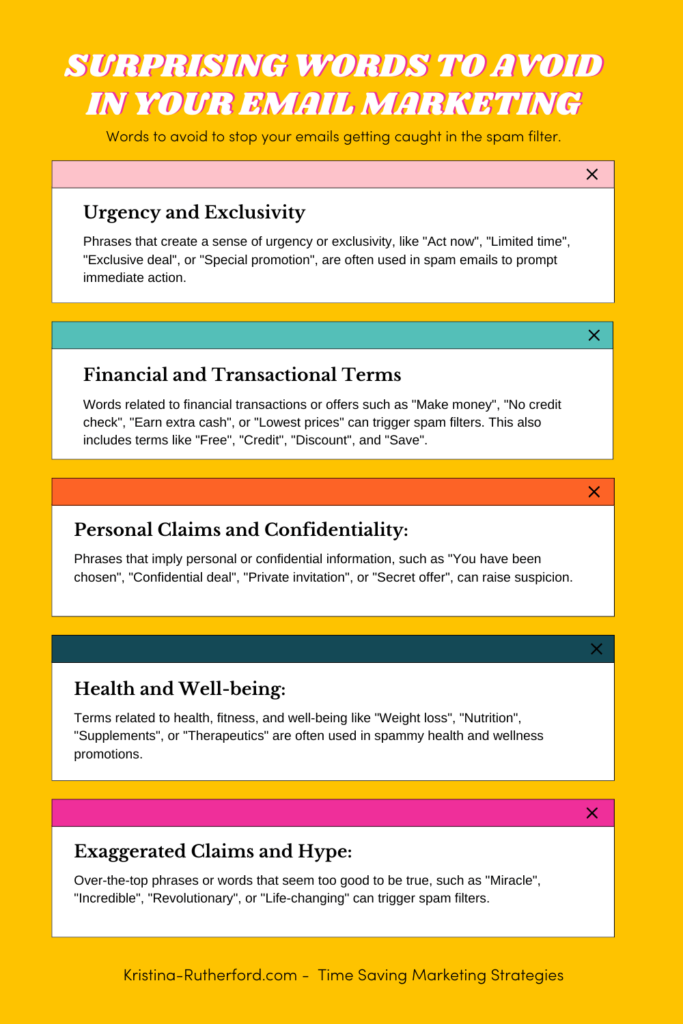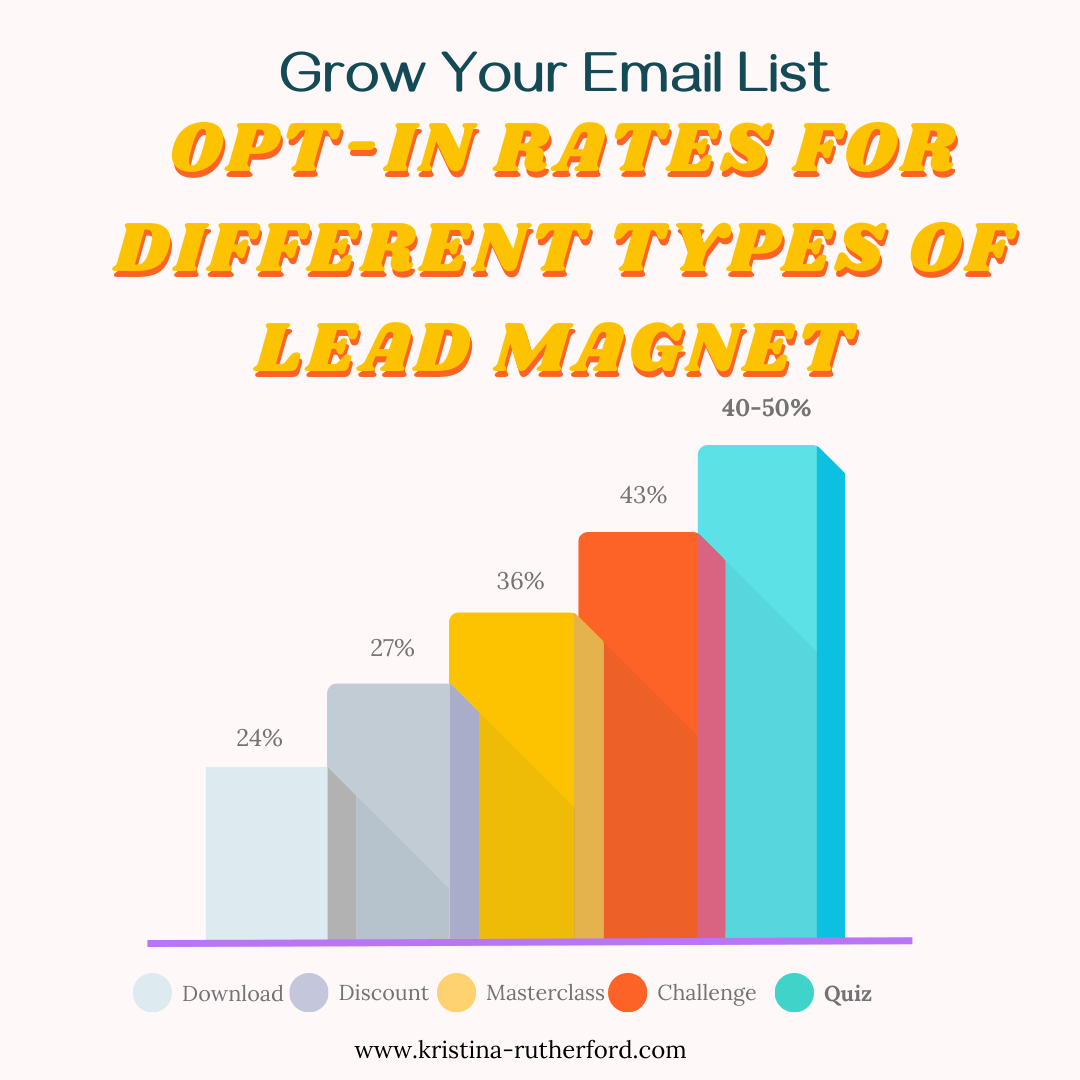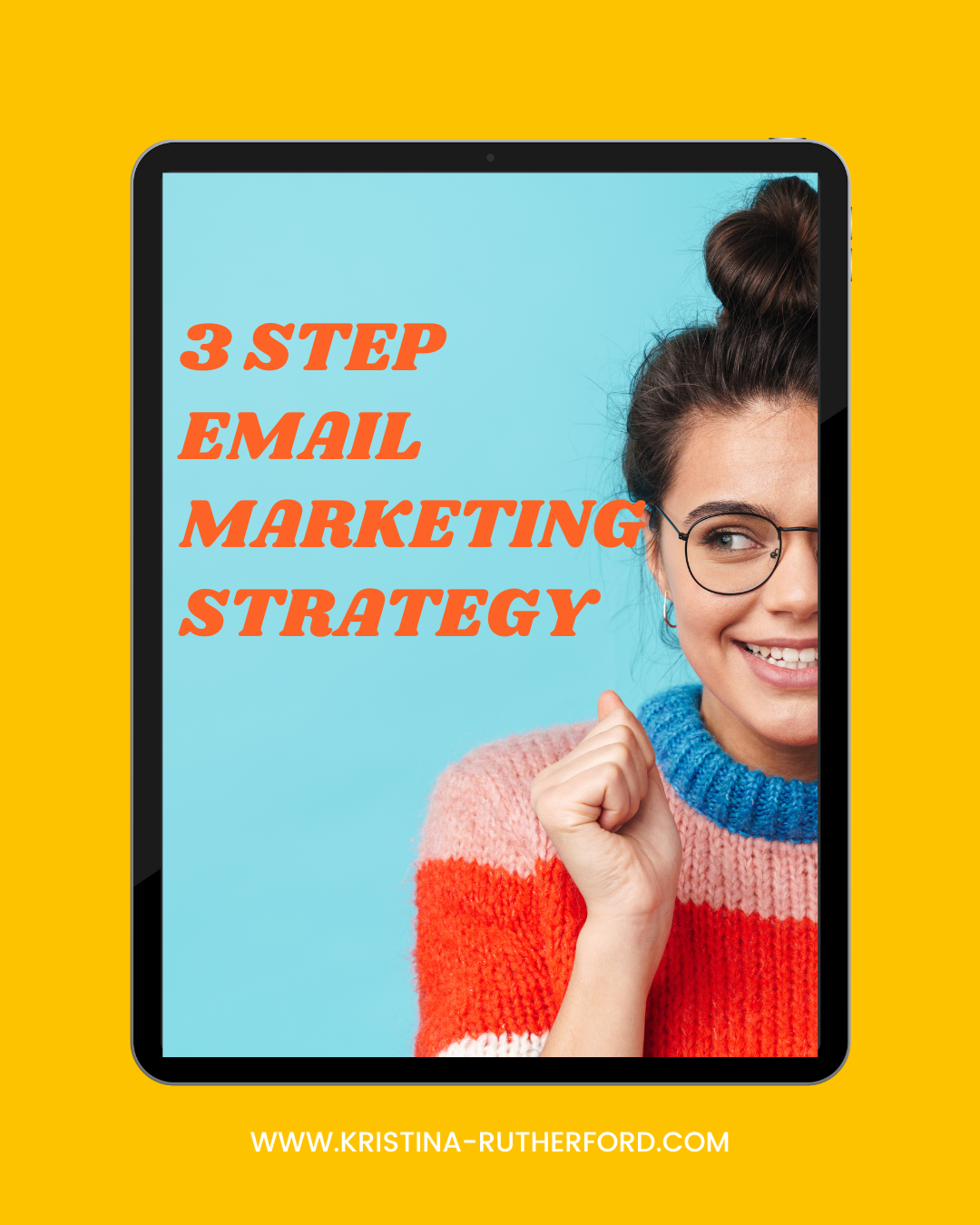Spam trigger words are words that have been identified as words that are often used in spam and phishing emails. If you include these words in your email marketing campaigns (emails to your list) it could end up with your email being incorrectly sent to the spam folder. Which would be devastating after you’ve carefully crafted that email.
To avoid having your emails flagged as spam, it’s crucial to be aware of and avoid using certain trigger words and phrases that are commonly associated with spam. These words can be categorised into several groups, each related to the type of content they typically appear in:
- Urgency and Exclusivity: Phrases that create a sense of urgency or exclusivity, like “Act now”, “Limited time”, “Exclusive deal”, or “Special promotion”, are often used in spam emails to prompt immediate action.
- Financial and Transactional Terms: Words related to financial transactions or offers such as “Make money”, “No credit check”, “Earn extra cash”, or “Lowest prices” can trigger spam filters. This also includes terms like “Free”, “Credit”, “Discount”, and “Save”.
- Personal Claims and Confidentiality: Phrases that imply personal or confidential information, such as “You have been chosen”, “Confidential deal”, “Private invitation”, or “Secret offer”, can raise suspicion.
- Health and Well-being: Terms related to health, fitness, and well-being like “Weight loss”, “Nutrition”, “Supplements”, or “Therapeutics” are often used in spammy health and wellness promotions.
- Exaggerated Claims and Hype: Over-the-top phrases or words that seem too good to be true, such as “Miracle”, “Incredible”, “Revolutionary”, or “Life-changing” can trigger spam filters.
- Suspicious Links and Attachments: Instructions related to links or attachments, for example, “Download now”, “Click here”, “Free download”, or “Open attachment”, especially if used in the subject line, can be problematic.

These categories encompass a wide range of terms, but it’s important to note that the context in which these words are used is also a significant factor. Spam filters have become more sophisticated and can often distinguish between legitimate use and potential spam. However, it’s still advisable to be cautious and avoid these terms where possible to improve your email deliverability.
How to use promotional language within your emails without using spam trigger words.
The following list provides different options for your promotional emails that help avoid triggering your marketing emails as spam.
- Original (Spammy): “Act Now to Claim Your Limited Time Offer!”
- Rephrased: “Discover Our Latest Offer Available for a Short Period”
- Original (Spammy): “Earn Extra Cash Instantly with This Incredible Opportunity!”
- Rephrased: “Learn How Our New [insert offer name] Can Help You Generate Additional Revenue”
- Original (Spammy): “Exclusive Deal Just for You: Save Big on Your Next Purchase!”
- Rephrased: “Enjoy Special Savings on Your Upcoming Purchase with Us”
- Original (Spammy): “Lose Weight Fast with Our Miracle Diet Plan!”
- Rephrased: “Explore Our Healthy Eating Plans Tailored for Effective Weight Management”
- Original (Spammy): “Click Here to Download Your Free E-book Now!”
- Rephrased: “Get Your Access to Our Complimentary E-book on Our Website”
In each rephrased version, notice the shift towards more informative and less aggressive language. This approach not only helps in avoiding spam filters but also aligns better with a tone of genuine communication and respect for the reader’s choice. Remember, the goal is to engage your audience with clarity and trustworthiness, not urgency and hype.
The Importance of Context in Email Communication in Avoiding Spam Trigger Words
Understanding the context in which you use certain phrases or words is crucial in email marketing when it comes to the spam filter. The same word can be safe or problematic depending on how it’s used. Let’s explore some examples:
- Example 1: Use of ‘Free’
- Potentially Spammy: “Get Your Free Trial Now!”
- Context-Aware Usage: “As part of our [insert reason for promotion], we are offering a no-cost trial of our service.”
- Explanation: The word ‘free’ often triggers spam filters, especially when used in a pushy or sales-oriented context. By framing it within a customer appreciation context, the message becomes less spam-like and more genuine.
- Example 2: Use of ‘Exclusive Offer’
- Potentially Spammy: “Exclusive Offer: Save 50% on all products!”
- Context-Aware Usage: “We’ve specially selected our newsletter subscribers to access a unique discount opportunity on our products.”
- Explanation: Instead of using ‘exclusive offer’ directly, which is a common phrase in spam emails, personalizing the message for a specific group (like newsletter subscribers) adds context and legitimacy.
- Example 3: Use of ‘Earn Money’
- Potentially Spammy: “Earn Money Fast by Joining Our Program!”
- Context-Aware Usage: “Learn how our partnership program can help you generate additional income through collaboration.”
- Explanation: Direct offers of money, especially with urgency, are common in spam. Providing a clear, professional explanation of the program and its benefits offers context and reduces spamminess.
- Example 4: Use of ‘Urgency’
- Potentially Spammy: “Hurry! Limited Time Offer!”
- Context-Aware Usage: “This special promotion is available until [specific date], so we encourage you to explore it soon.”
- Explanation: Creating urgency can trigger spam filters. Providing a specific date or timeframe offers a clear context and reduces the perception of spam.
In each case, the context-aware usage not only reduces the likelihood of triggering spam filters but also enhances the quality of communication. It’s about striking a balance: you want your emails to be engaging and actionable, without resorting to phrases that might be construed as overly aggressive or spammy. By focusing on the context and framing your message appropriately, you can effectively communicate with your audience while maintaining a professional and trustworthy tone.
Email Design Considerations to Avoid Spam Filters
While the content of your email is crucial, the design and layout play a significant role in avoiding spam filters. Small business owners should be mindful of these key design elements:
- Balanced Use of Images and Text: Emails that are heavy on images and light on text can raise red flags for spam filters. Ensure a good balance between text and images. Text should provide sufficient context and information, making the email valuable even if images are not displayed.
- Avoid Overuse of Large Fonts and Bright Colors: While it’s tempting to use large, bold fonts and bright colors to grab attention, overdoing it can make your email look like spam. Stick to a professional and clean design with standard font sizes and a color scheme that reflects your brand identity.
- Limit the Use of Exclamation Points and All Caps: In your email’s subject line and body, excessive use of exclamation points and capital letters can trigger spam filters. They can also be off-putting to readers. Use them sparingly and only for emphasis.
- Clean and Simple Layout: A cluttered email can be overwhelming and may be flagged as spam. Opt for a clean, simple layout that is easy to navigate. Use clear headings, bullet points, and enough white space to make the email easy to read.
- Optimize for Mobile Devices: With more people reading emails on their phones, ensure your email design is responsive and looks good on various screen sizes. If an email doesn’t display correctly on mobile devices, it might not only turn away readers but also trigger spam filters.
- Avoid Overuse of Links: Too many links in an email can be a red flag for spam filters. Use links judiciously and ensure they are relevant to your content. Also, avoid shortening links, as this can sometimes be viewed suspiciously by email providers.
- Testing Your Email Design: Before sending out your email, test it across different email clients and devices. This will help you see how your email is displayed and make adjustments as necessary. Many email marketing tools offer testing features to preview how your email looks in various inboxes.
Incorporating these design elements will not only help your emails avoid spam filters but also enhance the overall user experience. A well-designed email reflects professionalism and can significantly increase engagement rates.
Conclusion
As we wrap up our discussion on navigating the challenges of email marketing for small business owners, it’s clear that understanding and avoiding spam triggers is just one part of a larger, more dynamic puzzle. Let’s recap the key takeaways:
- Avoid Spam Trigger Words and Phrases: Be mindful of the language used in your emails. Avoid overused sales language and phrases that are commonly associated with spam.
- Understand the Importance of Context: Context matters. Tailor your messaging to align with your audience’s needs and interests while keeping it authentic and clear.
- Pay Attention to Email Design: A balanced, clean, and mobile-friendly design is crucial. Avoid design elements that could be mistaken for spam.
Now, it’s your turn to take these insights and apply them to your email marketing efforts. Remember, successful email marketing is about building and maintaining relationships with your audience. If you’d like to learn more read my blog post: Why your emails end up in the spam folder and how you can avoid it.
If you want to get improve your marketing, make more sales then take my quiz where you will get a customised 3 step action plan to level up your marketing.




+ show Comments
- Hide Comments
add a comment